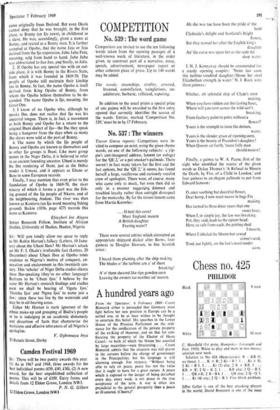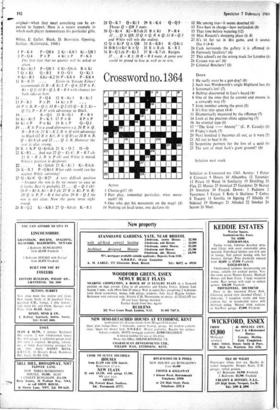Chess no. 425
PHILIDOI?
Black White 9 men 10 men
C. Mansfield (1st prize. Hampshire Telegraph and Post, 1919). White to play and mate in two moves; solution next week.
Solution to No 424 (Beszczynski): R – KB 6!, no threat. 1 . K x R; 2 Kt – B 3. 1 ... Kt x R; 2 Kt – B 5. 1 . . . Kt (2) else: 2 R x KR. 1 . . . KR x R; 2 Q – K 2. 1 . . . KR else; 2 Q – B 5.
1 QR x R; 2 R –B4. 1 QR else; 2 Q–Q 3. 1 ... Kt (4) any; 2 Q – B 3. Fine block problem.
Effim Geller is one of the best attacking players in the world; David Bronstein is one of the most
original—when they meet something can be ex- pected to happen. Here is a recent example in which each player demonstrates his particular gifts.
White, E. Geller. Black, D. Bronstein. Opening, Sicilian. (Kislovodsk, 1968.) 1 P–K4 P–QB4 2 Kt–KB 3 Kt–QB 3 3 P–Q4 P X P 4 Kt x P P–K 4 The first sign that no quarter will be asked or given.
5 Kt –Kt 5 P – QR 3 6 Kt–Q6ch B X Kt 7 Q x Kt Q–B 3 8 Q–Q I Q–Kt 3 9 Kt–B3 KKt–K2 10 P– KR 4 P– KR 4
11 R – R 3? . . . Estrin in 'Europe. Echecs' recommends 11 B – K Kt 5, P – Q 4; 12 P X P, Kt – Q 5; 13 B – Q 3, B – 8 4 with chances for both sides as best.
11 . . . P–Q4 12 R –Kt 3 B–Kt 5 13 P–B 3 P x P! 14 Kt x P /4 P x B, R – Q 1; 15 B – Q 2 (15 Q – K 2, Kt – Q 5!). P – B 4! with advantage to Black.
14 . . . R–Q1 15 B–Q3 P–B 4 16 Kt–Kt 5 P--*K 5 17 P x B RP x P 18 KtxP PxKt 19 RxP Q–Q3 19 . • R X P is a good alternative e.g. 20 R X Q.
R – R 8 ch; 21 K – K 2, R X Q with advantage to Black (22 R x Kt?, R X Q B!) or 20 R X R, Q – Kt 6 ch and 21 . . . Q x R. However the text is also strong.
20 R x KP Q–Kt6ch 21 K – Q 2 0-0 22 K–B3... And not 22 Q Kt 4?. R – 13 7 ch;
23 K – B 3, R x P ch! and White is mated. White's position is desperate.
22 . . . Kt–Q4ch 23 K –Kt 3 Kt–R4ch 24 K –R 3 P–Q Kt 4 What odds would you lay against White surviving?
25 Q – Kt 4! Q – B 2? A very difficult position —because the win is by no means so easy as it looks. Best is probably 25 . . . Q – Q 3 chi;
26 P – Kt 4, Kt – B 5 ch; 27 R X Kt, P X R; 28 Q X P, P– R 4 but after 29 B– Q 2 the win is not clear. Now the game turns right round.
26 B – Q 2 Kt –KB 3 27 Q – K6 ch K – R 1 28 Q–K7 Q–Kt3 29 R–K 6 Q–Q5 Threat Q – QR 5 mate.
30 Q–Kt 4 Kt–B5 ch 31 B x Kt P–R 4 31 . . . Q X QB; 32 Q x Q, R X Q; 33 B– Q 3 and White will win the ending.
32 Q x Kt P Q x QB 33 R–KB I R–QKtI 34 R(B1)xKt! R x Q 35 R x R ch K –R 2 36 B– Q 3 ch P– Kt 3 37 R– K 7 ch Resigns 37 . . . K – R 3; 38 R – R 8 mate. A game one could be proud to lose as well as to win:







































 Previous page
Previous page